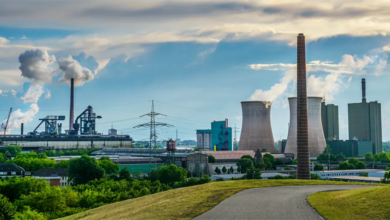Upper Midwest Counties Attempt to Block CCS Pipeline – Watts Up With That?

Guest “NIMBY’ism?” by David Middleton
- CCS: Carbon (technically CO2) Capture and Sequestration (or Storage)
- CCUS: CCS+ Utilization
- NIMBY: Not In My Back Yard
- NIMBY’ism: Actively opposing something because it’s too close to home.
Technically the counties are attempting to block the use of eminent domain in the construction of this pipeline project.
Counties taking action against eminent domain for carbon capture pipeline
Some North Dakota counties have passed resolutions against using eminent domain for right-of-way for a carbon capture pipeline. Iowa-based Summit Carbon Solutions is behind a $4.5 billion project that covers five states.By Jeff Beach April 18, 2022
KINDRED, N.D. — Todd McMichael looks out over pasture land that his family owns along the Sheyenne River expecting to see prairie chickens, deer and pheasants.
When it greens up, there will be cattle grazing on the land near Kindred, North Dakota, that has never been tilled.
What he doesn’t want to see is workers sinking a pipeline into the ground.
McMichael describes himself as becoming a “mouthpiece” for landowners in the path of the Summit Carbon Solutions pipeline in North Dakota who object to the threat of eminent domain to gain right-of-way for the pipeline.
He made a presentation in front of his county board in March, which unanimously adopted a resolution: “That the Richland County Commission officially opposes eminent domain for the Summit Carbon Solutions Pipeline within Richland County, North Dakota.”
Neighboring Sargent County has passed a similar resolution. McMichael says there are presentations soon to be made in Dickey and Emmons counties and conversations taking place with landowners in Burleigh and Morton counties.
[…]
In northern South Dakota, McPherson County has issued a moratorium on pipeline construction, but Bruce Mack, an organizer of opponents there, said that is part of county effort to upgrade its zoning and there are moratoriums against large hog barns and wind turbines also. But he added that there is “very stiff opposition” in the county.
[…]
A letter of opposition filed April 5 by commissioners of Brown County, which includes Aberdeen, reads, in part: “The farmers who will be affected by this pipeline are refusing to sign easements that are being offered to them by SCS Carbon Transport. This company is using strong-arm tactics in response to the refusal to sign these easements. The affected farmers fear the inevitable use of eminent domain and the loss of private property rights.
“There is great concern about the safety of the SCS Carbon Transport pipeline. With the pipe being placed only four feet underground and at 2100 PSI, if this pipeline should happen to rupture, there could be serious human and animal consequences.”
[…]
Liquid carbon dioxide is a hazardous material, and a rupture of a carbon dioxide pipeline in Mississippi sickened dozens of people. Opponents add that carbon dioxide can render emergency vehicles useless by robbing the air of the oxygen needed for gas engines to run.
[…]
North Dakota Gov. Doug Burgum, a supporter of the project, has stated that eminent domain would not be employed. Although, since the pipeline system would be a “common carrier,” eminent domain is certainly applicable.
It’s not clear whether the opponents simply oppose pipelines, CO2 pipelines in particular, or just want to be left alone. Whatever, the case, this project will almost certainly move forward.
Safety
All industrial activities are hazardous at some level. In terms of transporting oil, petroleum products, natural gas and hazardous gases and liquids, pipelines are the safest form of transportation.
Pipelines are the safest, most reliable way to transport energy
US Department of Transportation data shows pipelines are the safest mode of energy transportation. Accidents are rare. According to the most recent numbers available, 99.999997% of gas and crude oil is moved safely through interstate transmission pipelines. Statistics from the National Transportation Safety Board show pipelines make up less than one one-hundredth of one percent (0.01%) of all transportation accidents in the U.S.
I was going to post the graphs from the U.S. Department of Transportation, Pipeline and Hazardous Materials Safety Administration (PHMSA), but their website (or my browser) isn’t cooperating at the moment.
As of 2015, there were over 4,500 miles of CO2 pipelines in operation in the US and Saskatchewan.
Spanning across more than a dozen U.S. states and into Saskatchewan, Canada, a safe and
regionally extensive network of carbon dioxide (CO2) pipelines has been constructed over the
past four decades. Consisting of 50 individual CO2 pipelines and with a combined length over
4,500 miles, these CO2 transportation pipelines represent an essential building block for linking the capture of CO2 from electric power plants and other industrial sources with its productive use in oilfields and its safe storage in saline formations. Expanding this system could help to enable fossil-fired power generation in a carbon constrained environment and increase energy security by enhancing domestic oil production.The vast majority of the CO2 pipeline system is dedicated to enhanced oil recovery (CO2-EOR),
connecting natural and industrial sources of CO2 with EOR projects in oil fields. Roughly 80
percent of CO2 traveling through U.S. pipelines is from natural (geologic) sources; however, if
currently planned industrial CO2 capture facilities and new pipelines are built, by 2020 the
portion of CO2 from industrial-sources could be nearly equal to that from natural sources. In
terms of future potential, it is estimated that up to 4 million barrels per day of oil could
potentially be produced in the U.S. with CO2-EOR and that 85% of this would be reliant on
industrial CO2; contributing to significantly fewer oil imports and annual emissions reductions of 400 MMTCO2, by 2030.A Review of the CO2 Pipeline Infrastructure in the U.S., 2015, US Department of Energy
The February 2020 Mississippi incident involved Denbury’s Delta Pipeline, which transports CO2 and H2S from Jackson Dome to Delhi oil field, where the CO2 is used for enhanced oil recovery (EOR).
Denbury has had a couple of well control incidents, leading to no human fatalities. One of the incidents, a 2011 blow out in Delhi Field, resulted in the company being hit with one of the largest environmental fines in Mississippi state history (there’s some hidden sarcasm here).
Industrial accidents happen. Everyone I know of in the oil & gas industry does everything possible to avoid accidents, mostly be avoiding the conditions that lead to accidents. This effort was seriously magnified after Macondo (Deepwater Horizon).
The rupture of the Delta Pipeline was “the first known instance of an outdoor mass exposure to piped CO2 gas anywhere in the world“… (No, Lake Nyos isn’t an example.)
Right now, the only articles about this incident are hair-raising tales resembling a zombie apocalypse. This is not meant to diminish the seriousness of this pipeline breach. It’s imperative that the cause(s) be identified. The PHMSA hasn’t issued a report on this yet. We won’t know the causes and/or possible preventive measures until they issue a report.
What are these counties trying to block?
Summit Carbon Solutions is partnering with more than 30 ethanol plants across a five-state region. Located in Iowa, Minnesota, North Dakota, South Dakota, and Nebraska, this meaningful investment in the future of agriculture will capture carbon dioxide from the fermentation process of biorefineries such as ethanol plants, compress the captured CO2, and channel it to North Dakota where it will be permanently and safely stored underground in deep geologic storage locations. Doing so will drastically reduce the carbon footprint of ethanol production and enhance the long-term economic viability of the ethanol and agriculture industries. As one of the largest private investments in the region, Summit Carbon Solutions’ project will generate thousands of jobs during construction and hundreds of full-time jobs once operational.
The largest oil producer in North Dakota, Continental Resources, recently joined the project.
Continental Resources ventures into carbon capture with 5-state ethanol project
Oil developer Continental Resources says it can lend its expertise on the geology of North Dakota, where greenhouse gases from 31 ethanol plants will be stored underground. Summit Carbon Solutions is behind the $4.5 billion project.By Jeff Beach March 02, 2022
CASSELTON, N.D. — Continental Resources, which helped drive a resurgence in North Dakota’s oil industry, is investing in what is being billed as the largest carbon capture project in the world — taking greenhouse gas emissions from ethanol plants and storing it underground in North Dakota.
Iowa-based Summit Carbon Solutions on Wednesday, March 2, announced a $250 million investment from Continental Resources, which also will contribute it’s expertise in North Dakota’s geology.
In an interview, Harold Hamm, the founder of Continental Resources said the storage area in Mercer and Oliver counties west of Bismarck, is an “ideal place” for carbon storage, a key component of North Dakota’s goal to be carbon neutral by 2030.
“We believe that this is the right thing to do for the right reasons, for the environment, for ag, for industry, for the country, and that’s why we’re here,” Hamm said.
[…]
Tharaldson Ethanol is one of 31 ethanol producers in five states to sign on to the Summit Carbon Solutions pipeline. The $4.5 billion project called the Midwest Carbon Express would benefit ethanol plants by allowing them to sell fuel on the low-carbon market for a premium price.
Gary Tharaldson, the owner of Tharaldson Ethanol, said the buy-in of Hamm and Continental Resources, “is going to make this better for us than we had already expected.”
[…]
Summit says it isn’t asking for any of the ethanol plants to help pay for the pipeline project, instead, it would take a percentage of the premium price that ethanol plants would get in the low-carbon markets, such as California.
Summit also is banking on a federal tax credit of $50 for every ton of carbon dioxide that is permanently stored.
[…]
In terms of CO2 capture, ethanol plants are “low hanging fruit”.
Why CCUS for Ethanol Producers? Why Now?
Ethanol producers are uniquely positioned to take advantage of financial incentives for CCUS right now. Here’s why:
*CO2 released during the fermentation stage of ethanol production is highly purified, with just a bit of water to remove.
*Most ethanol producers in the U.S. are located in areas with favorable geology (particularly through the Midwest and heartland) and near oil producers in need of purified CO2 for EOR.
*Changes to the 45Q tax credit have made monetization of CCUS more viable for smaller CO2 emitters, including ethanol producers.
The geology of the Williston Basin is well-suited for CCS. The area being considered for the injection site has been extensively investigated. In terms of understanding the geology and drilling operations in the Williston Basin, no one is better than Continental Resources.
Why do it?
For starters, North Dakota’s Republican governor supports it:
Burgum touts goal to make North Dakota carbon neutral by 2030
AMY R. SISK May 12, 2021Gov. Doug Burgum announced a goal Wednesday to make North Dakota carbon neutral by the end of the decade.
He challenged the state’s energy and agriculture industries to work toward the goal through innovation, a theme he has repeated frequently throughout his four years in office. Increasingly, states and businesses are pledging to go “carbon neutral” in an effort to address climate change.
Burgum envisions reaching the goal while maintaining robust oil and coal industries in North Dakota.
“This may seem like a moonshot, but it’s actually not,” Burgum said to a room full of oil industry workers and executives at the Williston Basin Petroleum Conference being held this week at the Bismarck Event Center. “This is actually completely doable.”
[…]
Burgum cited several carbon capture and storage projects underway as means to achieve the 2030 deadline…
[…]
The governor mentioned enhanced oil recovery efforts in the state as well. The process involves injecting carbon dioxide into depleted oil fields to boost oil production. Denbury Resources is involved in a sizable operation using the technique in the southwestern part of the state.
“We have hit the geologic jackpot in North Dakota,” Burgum said.
North Dakota has the capacity to store over 250 billion tons of carbon emissions, Burgum said. The governor based his goal around an estimate of 30 million tons per year of carbon dioxide released by energy production in the state, a figure from the University of North Dakota’s Energy & Environmental Research Center.
[…]
There’s no doubt that this can be done from a geological and engineering perspective. The 45Q tax credit and other “low carbon” incentives certainly appear to make it economically viable.
Why does North Dakota care if its oil & gas production is “carbon neutral”?
Two friends were walking through the woods when they attracted the attention of a vicious-looking bear. The bear noticed them and started to walk toward them.
The first man immediately opened his backpack, pulled out a pair of sneakers and started putting them on. The second man looked at him and said: “You’re crazy! You’ll never be able to outrun that bear!”
“Oh, I know that. Bears are much faster than humans. I have no hope of ever being able to outrun a bear.”
“If you know that, why are you changing shoes?” his friend asked.
“Well, the way I figure it,” the first man replied. “I don’t have to outrun the bear. I only have to outrun you.”
You don’t have to outrun the bear (government), you just have to outrun your soon-to-be-former friend (competitor).
IHS Markit says that 71 CCS and CCUS projects are operating, in some stage of development, or have been announced in the US. Existing projects can capture up to 25 million metric tons (mt)/year of CO2-equivalent, and nearly 85 million mt/year of additional capacity is in development, IHS Markit said in a report published on 30 November.
The assumption is that government, investors and financial institutions will continue to incentivize and/or coerce increased investment in CCS and that the “value” of these incentives and coercions will also continue to increase. There is currently strong bipartisan support for CCS/CCUS at the Federal level and in many states, particularly fossil fuel producing states.
While this makes sense from an oil company perspective, something recently occurred to me: Will persistently high oil & gas prices, coupled with the supply chain disruptions and commodities inflation being driven by the Quixotic quest for “green energy” kill support for efforts to reduce the carbon intensity of energy production? Could hyper-inflated food prices kill support for ethanol produced from corn and other food stuffs?
Could the electorate suddenly decide to say, “Eighty-six the climate change BS! We want affordable, reliable energy now! We’ll deal with the whatever the weather does in the future!” If the CCS incentives continue to grow, we will continue to produce oil & gas and do CCS. If the CCS incentives go away, we go back to just producing oil & gas. Either way, it’s a “win” for the oil & gas industry.
So…





